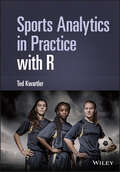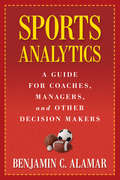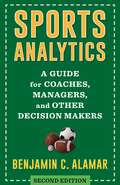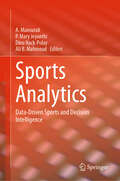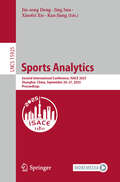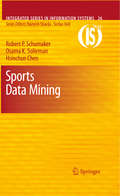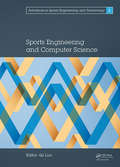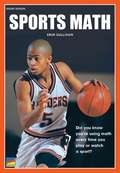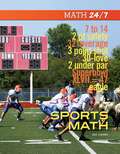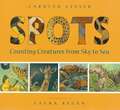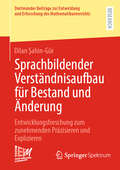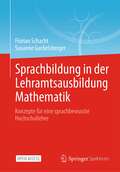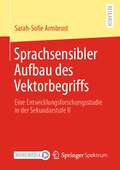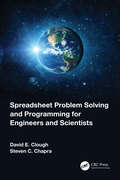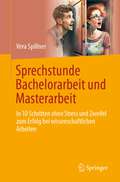- Table View
- List View
Sport Analytics: A data-driven approach to sport business and management
by Gil Fried and Ceyda MumcuThe increasing availability of data has transformed the way sports are played, promoted and managed. This is the first textbook to explain how the big data revolution is having a profound influence across the sport industry, demonstrating how sport managers and business professionals can use analytical techniques to improve their professional practice. While other sports analytics books have focused on player performance data, this book shows how analytics can be applied to every functional area of sport business, from marketing and event management to finance and legal services. Drawing on research that spans the entire sport industry, it explains how data is influencing the most important decisions, from ticket sales and human resources to risk management and facility operations. Each chapter contains real world examples, industry profiles and extended case studies which are complimented by a companion website full of useful learning resources. Sport Analytics: A data-driven approach to sport business and management is an essential text for all sport management students and an invaluable reference for any sport management professional involved in operational research.
Sport and Migration: Borders, Boundaries and Crossings
by Joseph MaguireFrom Major League Baseball to English soccer’s Premier League, all successful contemporary professional sports leagues include a wide diversity of nationalities and ethnicities within their playing and coaching rosters. The international migration of sporting talent and labor, encouraged and facilitated by the social and economic undercurrents of globalization, mean that world sport is now an important case study for any student or researcher with an interest in international labor flows, economic migration, global demography or the interdependent world economy. In this dazzling collection of papers, leading international sport studies scholars chart the patterns, policies and personal experiences of labour migration within and around sport, and in doing so cast important new light both on the forces shaping modern sport and on the role that sport plays in shaping the world economy and global society. Presenting original case studies of sports from European and African soccer to Japanese baseball to rugby union in New Zealand, the book makes an important contribution to our understanding of a wide range of issues within contemporary social science, such as national identity politics, economic structure and organization, north-south relations, imperial legacies and gender relations. This book is invaluable reading for students and researchers working in sport studies, human geography, economics or international business.
Sport- und Gesundheitstourismus 2030: Wie die „Generation plus“ den Markt verändert
by Pamela Heise Michaela Axt-GadermannDieses Fachbuch fokussiert auf das sport- und gesundheitstouristische Nachfrageverhalten der "Generation plus". Einer Konsumentengruppe in ihrer zweiten Lebenshälfte, die mit einer großen Neugier in Bezug auf sich selbst und die Welt und einem Plus an Interessen, Anspruch und Kaufkraft ausgestattet ist. Durch die sich wandelnden soziodemographischen, ökonomischen und klimatischen Rahmenbedingungen ergeben sich auch im Bereich der Freizeit- und Tourismusbranche signifikante Änderungen zu den bisherigen Nachfrage- und Angebotsstrukturen. Destinationen, die sich bereits jetzt mit der wachsenden Zahl reifer Touristen beschäftigen, stellen ihre Weichen in Richtung Zukunft.Das Buch greift vor dem Hintergrund des demographischen Wandels aktuelle touristische Entwicklungen und zukünftige Herausforderungen auf, denen sich Destinationen und Anbieter im Sinne der Wettbewerbsfähigkeit stellen müssen. Das Buch richtet sich durch die Symbiose aus Theorie und Praxis im Sinne eines Handlungsleitfadens u.a. an Entscheider und Produktentwickler im touristischen Destinations- und Eventkontext, an Lehrende und Studierende sowie an alle, die eine anregende Lektüre suchen.
Sportinformatik: Modellbildung, Simulation, Datenanalyse und Visualisierung von sportbezogenen Daten
by Daniel MemmertIn den letzten Jahren ist die Sportinformatik extrem gewachsen, vor allem weil immer mehr und neuere Daten verfügbar wurden. Sportinformatische Tools – sei es im Training zur Gegnervorbereitung, im Wettkampf oder in der Wissenschaft – sind im Sport heute auf unterschiedlichen Expertise-Ebenen unverzichtbar. Durch den Einsatz in den vier großen Anwendungsfeldern Vereine und Verbände, Wirtschaft, Wissenschaft sowie Medien ist ein völlig neuer Markt entstanden, der innerhalb der universitären Forschungs- und Lehraktivitäten zunehmend an Bedeutung gewinnt.Dieses Lehrbuch möchte der mittlerweile breiten Vielfalt der Sportinformatik gerecht werden, indem mehr als 30 Autorinnen und Autoren aus ihrem Spezialgebiet berichten und neueste Erkenntnisse prägnant zusammenfassen. Das Werk gliedert sich in vier Hauptabschnitte: Datensätze, Modellbildung, Simulation sowie Datenanalyse. Neben Hintergründen zu Programmiersprachen und zur Visualisierung wird es von der Historie und einem Ausblick eingerahmt. Studierende mit Bezug zur Sportwissenschaft erhalten einen umfassenden Einblick in die Sportinformatik, unterstützt durch ein didaktisch ausgefeiltes Konzept, das eine einfache Vermittlung der Lerninhalte ermöglicht. Zahlreiche digitale Übungsfragen untermauern den Lerneffekt und gewährleisten eine optimale Prüfungsvorbereitung. Für Fortgeschrittene bietet die vertiefende Diskussion von Zeitreihen Data Mining, künstlichen neuronalen Netzwerken, Convolution Kernel, Transfer Learning und Random Forests einen zusätzlichen Mehrwert.
Sports Analytics in Practice with R
by Ted KwartlerSports Analytics in Practice with R A practical guide for those looking to employ the latest and leading analytical software in sport In the last twenty years, sports organizations have become a data-driven business. Before this, most decisions in sports were qualitatively driven by subject-matter experts. In the years since numerous teams found success with “Money Ball” analytical perspectives, the industry has sought to advance its analytical acumen to improve on- and off-field outcomes. The increasing demand for data to inform decisions for coaches, scouts, and players before and during sporting events has led to intriguing efforts to build upon this quantitative approach. As this methodology for assessing performance has matured and grown in importance, so too has the open-source R software emerged as one of the leading analytical software packages. In fact, R is a top 10 programming language that is useful in academia and industry for statistics, machine learning, and rapid prototyping. Sports Analytics in Practice with R neatly marries these two advances to teach basic analytics for sports-related use—from cricket to baseball, from basketball to tennis, from soccer to sports gambling, and more. Sports Analytics in Practice with R readers will also find: A broad perspective of sports, focusing on a wide range of sports rather than just one The first book of its kind that features coding examples Case study approach throughout the book Companion website including data sets to work through alongside the explanations Sports Analytics in Practice with R is a helpful tool for students and professionals in the sports management field, but also for sports enthusiasts who have a coding background.
Sports Analytics: A Guide for Coaches, Managers, and Other Decision Makers
by Benjamin AlamarBenjamin C. Alamar founded the first journal dedicated to sports statistics, the Journal of Quantitative Analysis in Sports. He developed and teaches a class on sports analytics for managers at the University of San Francisco and has published numerous cutting-edge studies on strategy and player evaluation. Today, he cochairs the sports statistics section of the International Statistics Institute and consults with several professional teams and businesses in sports analytics. There isn't a better representative of this emerging field to show diverse organizations how to implement analytics into their decision-making strategies, especially as analytic tools grow increasingly complex. Alamar provides a clear, easily digestible survey of the practice and a detailed understanding of analytics' vast possibilities. He explains how to evaluate different programs and put them to use. Using concrete examples from professional sports teams and case studies demonstrating the use and value of analytics in the field, Alamar designs a roadmap for managers, general managers, and other professionals as they build their own programs and teach their approach to others.
Sports Analytics: A Guide for Coaches, Managers, and Other Decision Makers
by Benjamin AlamarData and analytics have the potential to provide sports organizations with a competitive advantage both on and off the field. Yet even as the use of analytics in sports has become commonplace, teams regularly find themselves making big investments without significant payoff.This book is a practical, nontechnical guide to incorporating sports data into decision making, giving leaders the knowledge they need to maximize their organization’s investment in analytics. Benjamin C. Alamar—a leading expert who has built high-performing analytics groups—surveys the current state of the use of data in sports, including both specifics around the tools and how to deploy them most effectively. Sports Analytics offers a clear, easily digestible overview of data management, statistical models, and information systems and a detailed understanding of their vast possibilities. It walks readers through the essentials of understanding the value of different types of data and strategies for building and managing an analytics team. Throughout, Alamar illustrates the value of analytics with real-world examples and case studies from both the sports and business sides.Sports Analytics has guided a range of sports professionals to success since its original publication in 2013. This second edition adds examples and strategies that focus on using data on the business side of a sports organization, provides concrete strategies for incorporating different types of data into decision making, and updates all discussions for the rapid technological developments of the last decade.
Sports Analytics: Data-Driven Sports and Decision Intelligence
by Dieu Hack-Polay Ali B. Mahmoud P. Mary Jeyanthi A. MansuraliIn "Sports Analytics: Data-Driven Sports and Decision Intelligence," embark on a journey through the exhilarating world of sports enhanced by the power of data-driven insights. From the nail-biting moments on the field to the strategic decisions behind the scenes, this comprehensive guide unveils the secrets that propel teams to victory and champions to greatness.It explores the cutting-edge techniques and methodologies that revolutionize the way we understand and analyze sports performance. From player evaluations to game strategies, injury prevention to fan engagement, this book equips you with the tools to gain a competitive edge in any sport. Whether you're a coach, player, analyst, or simply a passionate fan, this book will change the way you see the game. This book details how to use analytics and machine learning to highlight key performance indicators (KPIs) of sports for analysis. The authors show how to apply various statistical techniques, machine learning and data mining algorithms for on-field and off-field analysis. They go on to show how analytical algorithms are used in the sports ecosystem to derive solutions for the team and leadership, helping team managers and coaches to monitor games and player information through dashboards. The book then shows how to deploy machine learning algorithms for validating and improving teams and players performance. The book is relevant to professionals and academics working in machine learning and data analysis related to sports.
Sports Analytics: Second International Conference, ISACE 2025, Shanghai, China, September 26–27, 2025, Proceedings (Lecture Notes in Computer Science #15925)
by Jing Sun Jin-Song Dong Xiaofei Xie Kan JiangThis book LNCS 15925 constitutes the refereed proceedings of the Second International Conference on Sports Analytics, ISACE 2025, held in Shanghai, China, during September 26-27, 2025. The 21 full papers were carefully reviewed and selected from 57 submissions. These papers explore the frontiers of sports analytics, which is an interdisciplinary field that integrates artificial intelligence, data science, psychology, and smart devices to enhance athletic performance, strategy, and decision-making.
Sports Data Mining
by Hsinchun Chen Osama K. Solieman Robert P. SchumakerData mining is the process of extracting hidden patterns from data, and it's commonly used in business, bioinformatics, counter-terrorism, and, increasingly, in professional sports. First popularized in Michael Lewis' best-selling Moneyball: The Art of Winning An Unfair Game, it is has become an intrinsic part of all professional sports the world over, from baseball to cricket to soccer. While an industry has developed based on statistical analysis services for any given sport, or even for betting behavior analysis on these sports, no research-level book has considered the subject in any detail until now. Sports Data Mining brings together in one place the state of the art as it concerns an international array of sports: baseball, football, basketball, soccer, greyhound racing are all covered, and the authors (including Hsinchun Chen, one of the most esteemed and well-known experts in data mining in the world) present the latest research, developments, software available, and applications for each sport. They even examine the hidden patterns in gaming and wagering, along with the most common systems for wager analysis.
Sports Engineering and Computer Science: Proceedings of the International Conference on Sport Science and Computer Science (SSCS 2014), Singapore, 16-17 September 2014 (Advances in Sports Engineering and Technology)
by Qi LuoSports Engineering and Computer Science contains papers presented at the 2014 International Conference on Sport Science and Computer Science (SSCS 2014), held September 16-17, 2014 in Singapore and at the 2014 International Conference on Biomechanics and Sports Engineering (BSE 2014), held October 24-25, 2014, in Riga, Latvia. The contributions hav
Sports Math (Math 24/7)
by Rae SimonsThe speed of a pitch, the number of points scored, the time left on the clock . . . math is everywhere in the world of sports. Learn about the numbers and statistics behind sports like baseball, basketball, and football--and you'll find you understand the sports you love even better. In Sports Math, you'll discover that the math you learn in the classroom is just as important on the soccer field and basketball court.
Sports Research with Analytical Solution using SPSS
by J. P. VermaA step-by-step approach to problem-solving techniques using SPSS® in the fields of sports science and physical education Featuring a clear and accessible approach to the methods, processes, and statistical techniques used in sports science and physical education, Sports Research with Analytical Solution using SPSS® emphasizes how to conduct and interpret a range of statistical analysis using SPSS. The book also addresses issues faced by research scholars in these fields by providing analytical solutions to various research problems without reliance on mathematical rigor. Logically arranged to cover both fundamental and advanced concepts, the book presents standard univariate and complex multivariate statistical techniques used in sports research such as multiple regression analysis, discriminant analysis, cluster analysis, and factor analysis. The author focuses on the treatment of various parametric and nonparametric statistical tests, which are shown through the techniques and interpretations of the SPSS outputs that are generated for each analysis. Sports Research with Analytical Solution using SPSS® also features: Numerous examples and case studies to provide readers with practical applications of the analytical concepts and techniques Plentiful screen shots throughout to help demonstrate the implementation of SPSS outputs Illustrative studies with simulated realistic data to clarify the analytical techniques covered End-of-chapter short answer questions, multiple choice questions, assignments, and practice exercises to help build a better understanding of the presented concepts A companion website with associated SPSS data files and PowerPoint® presentations for each chapter Sports Research with Analytical Solution using SPSS® is an excellent textbook for upper-undergraduate, graduate, and PhD-level courses in research methods, kinesiology, sports science, medicine, nutrition, health education, and physical education. The book is also an ideal reference for researchers and professionals in the fields of sports research, sports science, physical education, and social sciences, as well as anyone interested in learning SPSS.
Spots: Counting Creatures from Sky to Sea
by Carolyn LesserFrom one leopard ray in the open ocean to ten tundra butterflies in the Arctic sky, Carolyn Lesser's playful language celebrates the rich and varied wildlife of our earth. Each of the ten creatures presented lives in a different biome.
Sprachbildender Verständnisaufbau für Bestand und Änderung: Entwicklungsforschung zum zunehmenden Präzisieren und Explizieren (Dortmunder Beiträge zur Entwicklung und Erforschung des Mathematikunterrichts #57)
by Dilan Şahin-GürMathematische Konzepte wie Bestand und Änderung spielen eine zentrale Rolle beim Deuten gesellschaftlicher Entwicklungen, z. B. in Pandemieschlagzeilen. Doch wie entwickeln Lernende Verständnis für diese Konzepte, und welche Rolle spielt dabei ihre Sprache? Dilan Şahin-Gür geht dieser Frage im Rahmen einer fachdidaktischen Entwicklungsforschung nach. Im Fokus stehen sprachliche Anforderungen beim Verständnisaufbau zu Bestand und Änderung, insbesondere syntaktische Strukturen beim Präzisieren und Explizieren. Die Arbeit rekonstruiert konzeptuelle Lernwege und zeigt, in welcher Weise gezielte Impulse zum Präzisieren und Explizieren Lernprozesse begleiten, als Teil der Gelingensbedingungen für Verständnisaufbau. Sie liefert empirisch fundierte Beiträge zur Theoriebildung und praxisrelevante Implikationen für einen sprachbildenden Mathematikunterricht zur Einführung in die Analysis.
Sprachbildung in der Lehramtsausbildung Mathematik: Konzepte für eine sprachbewusste Hochschullehre
by Florian Schacht Susanne GuckelsbergerWie lassen sich Fachdidaktik und Sprachbildung im Lehramtsstudium so verknüpfen, dass zukünftige Mathematiklehrkräfte optimal auf sprachbewussten Fachunterricht vorbereitet werden? Dieser Frage geht dieses Open Access Buch aus interdisziplinärer Perspektive nach – fachlich fundiert, forschungsorientiert und anschaulich:Die vorgestellten Leitideen und Design-Prinzipien für eine sprachbewusste Hochschullehre bilden den konzeptionellen Rahmen, der auch für die Weiterentwicklung eigener Lehrveranstaltungen genutzt werden kann.An zahlreichen empirischen Beispielen aus Schule und Hochschule werden Synergien zwischen Mathematikdidaktik und Sprachbildung aufgezeigt und Vorschläge für die konkrete Ausgestaltung der Hochschullehre gemacht.Einen besonderen Schwerpunkt bildet das Forschende Lernen in Praxisphasen an der Schnittstelle von Fach und Sprache.Impulse aus anderen Fachdidaktiken (Informatik, Chemie) eröffnen Transfermöglichkeiten.Mit seinen vielfältigen Einblicken in das hochaktuelle Thema Sprachbildung im Fachunterricht als Gegenstand einer sprachbewussten Hochschullehre ist das Buch für Hochschuldozierende und Studierende in der Lehramtsausbildung Mathematik gleichermaßen von Interesse.Das Buchbietet Konzepte für die Verknüpfung von Mathematikdidaktik und Sprachbildung in der Lehrkräfteausbildung Mathematik,ist interdisziplinär und forschungsorientiert,ist geeignet für Hochschuldozierende und Studierende.Das Buch ist unter den Bedingungen der Creative Commons Attribution 4.0 International License über SpringerLink (link.springer.com) frei zugänglich.
Sprachliche Variationen von mathematischen Textaufgaben: Entwicklung eines Instruments zur Textanpassung für Textaufgaben im Mathematikunterricht (Bielefelder Schriften zur Didaktik der Mathematik #5)
by David BednorzIn diesem Open-Access-Buch wird gezeigt, dass ein Instrument zur sprachlichen adaptiven Anpassung benötigt wird, um auf die sprachlichen Lernvoraussetzungen bei Textaufgaben von Lernenden im Mathematikunterricht reagieren zu können. Auf Basis eines quantitativen Vorgehens werden die sprachlichen Variationen in mathematische Textaufgaben festgestellt und als Grundlage für sprachliche Veränderungspraktiken genutzt. Anhand der Ergebnisse dieser Arbeit werden fünf Faktoren herausgestellt, die für die Variation von Textaufgaben bedeutsam sind: der erklärende, komprimierende, beschreibende, informative und instruktive Faktor. Zur Konzeption des Instruments werden der Einfluss auf die Aufgabenschwierigkeit und die Verbindung zu fachlich-kontextuellen Merkmalen bestimmt.
Sprachsensibler Aufbau des Vektorbegriffs: Eine Entwicklungsforschungsstudie in der Sekundarstufe II
by Sarah-Sofie ArmbrustIn diesem Buch wird auf Basis bereits etablierter Design-Prinzipien ein sprachsensibles Lehr-Lern-Arrangement zum Aufbau des Vektorbegriffs entwickelt. Dieses wird im Zuge einer Entwicklungsforschungsstudie mit Lernenden der Sekundarstufe II empirisch erprobt und erforscht. Dabei steht die qualitative Analyse individueller sprachlicher und fachlicher Lernverläufe im Fokus. Die Autorin liefert vielfältige Ergebnisse, die sowohl die mathematik-didaktische Forschung als auch die Bildungspraxis bereichern: Erstens wird ein sprachsensibles Lehr-Lern-Arrangement für den Vektorbegriff vorgestellt, dessen Lernwirksamkeit hinsichtlich des Aufbaus von Grundvorstellungen durch die Ergebnisse der empirischen Erprobung nahegelegt wird. Es kann folglich von Akteur*innen aus der Bildungspraxis für die Förderung von sprachlich und fachlich schwachen Lernenden eingesetzt werden. Zweitens werden auf theoretischer Basis sprachliche und fachliche Anforderungen des Themenbereichs Vektoren identifiziert. In diesem Rahmen werden auf der Grundlage von fachlichen Analysen Grundvorstellungen für den Vektorbegriff abgeleitet, wodurch einem bestehenden Forschungsdesiderat begegnet wird.
Spreadsheet Problem Solving and Programming for Engineers and Scientists
by David E. Clough Steven C. ChapraSpreadsheet Problem Solving and Programming for Engineers and Scientists provides a comprehensive resource essential to a full understanding of modern spreadsheet skills needed for engineering and scientific computations. Beginning with the basics of spreadsheets and programming, this book builds on the authors’ decades of experience teaching spreadsheets and programming to both university students and professional engineers and scientists. Following on from this, it covers engineering economics, key numerical methods, and applied statistics. Finally, this book details the Visual Basic for Applications (VBA) programming system that accompanies Excel. With each chapter including examples and a set of exercises, this book is an ideal companion for all engineering courses and also for self-study. Based on the latest version of Excel (Microsoft Excel for Microsoft 365), it is also compatible with earlier versions of Excel dating back to Version 2013. Including numerous case studies, this book will be of interest to students and professionals working in all areas of engineering and science.
Sprechstunde Bachelorarbeit und Masterarbeit: In 10 Schritten ohne Stress und Zweifel zum Erfolg bei wissenschaftlichen Arbeiten
by Vera SpillnerDieses Buch hilft Dir, Deine Bachelor- oder Masterarbeit erfolgreich und stressfrei zu erstellen. Von der Idee zur fertigen Arbeit werden schrittweise alle Etappen des wissenschaftlichen Arbeitens aufgezeigt und gemeinsam mit Dir eingeübt, um Deine Arbeit auf den richtigen Weg zu bringen. Die Abschlussarbeit im Studium ist kein Sprint, sondern ein Marathon. Vera Spillner zeigt Dir, wie Du diese Langstrecke bewältigst, wie Du die einzelnen Etappen planst, die wissenschaftlichen Anforderungen richtig erfüllst und Dich motivierst, wenn es mal schwierig wird. Als Betreuerin von Abschlussarbeiten hat die Autorin vielfach erlebt, dass ein systematisches Vorgehen plus eine positive Einstellung der Schlüssel zum Erfolg ist. Genau diesen Schlüssel hältst Du nun mit diesem Buch in den Händen. In dieser Sprechstunde werden Fragen, Schritte und Stolperfallen des wissenschaftlichen Arbeitens systematisch aufgearbeitet: Wie finde ich ein Thema, das auf meinen Interessen abgestimmt ist? Wie entwickle ich eine machbare und relevante Forschungsfrage? Welche Methode wende ich hierfür an? Wie schreibe ich ein Exposé, wie eine Einleitung? Was muss alles in die Gliederung? Wie finde ich einen Erst- und Zweitbetreuer? Wie viel Zeit sollte ich für meine Abschlussarbeit einplanen? Wie sieht wissenschaftliches Arbeiten aus? Was muss ich während der Schreibphase alles beachten? Was muss ich bei der Abgabe alles beachten?Die Autorin bietet für all diese Fragen (und mehr) Tipps, konkrete Vorschläge, Beispiele und gelegentliche Teepausen, um ohne Stress und Zweifel durch die Abschlussarbeit zu kommen.
SpringBoard Mathematics, Course 2
by Betty Barnett Allen Dimacali John NelsonNIMAC-sourced textbook
SpringBoard Mathematics: Algebra 2
by Betty Barnett Allen Dimacali John NelsonNIMAC-sourced textbook
SpringBoard Mathematics: Course 2 (Common Core Edition)
by College BoardWith its main goal to help students achieve high academic standards to meet their own goals and have a successful future in mathematics studies in school, at work and life too, Springboard Mathematics is written with the readers in mind.
SpringBoard Mathmatics: Algebra 1
by Betty Barnett Allen Dimacali John NelsonNIMAC-sourced textbook




